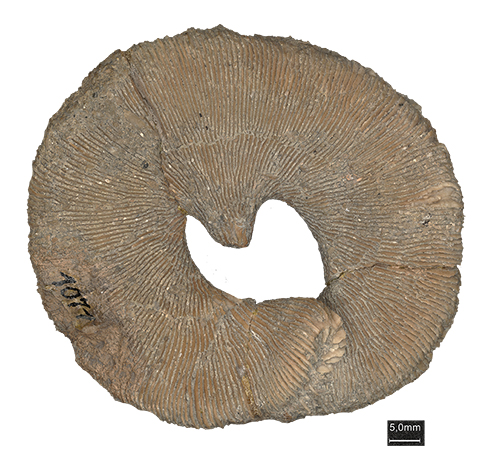April 2025: Moon-shaped coral
Diploctenium sp.
Upper Cretaceous (Santonian, c. 85 million years)
Gosau Group, Neffgraben, Austria
Fossil length: c. 7 cm
SNSB-BSPG 1997 XI 1071
In the Upper Cretaceous, around 85 million years ago, parts of Austria lay under a warm, subtropical sea. Islands had formed as a result of the formation of the Alps, which had already begun, and were scattered along the shallow waters. Organisms from this time interval were deposited in the Gosau Group and their fossils can be found today to the south-east of Salzburg, among other places. For example, an enormous richness of stony coral species can be found. Stony corals, scientifically known as Scleractinia, originated in the Middle Triassic around 240 million years ago and form today the colourful coral reefs in the tropics. Typical of this group of animals is the calcareous skeleton that surrounds the tentacle-bearing soft body, the so-called polyp. There are solitary stony corals, which consist of only a single polyp, or colonial forms with numerous polyps.

Diploctenium is a special fossilised coral genus from the Gosau Group. This coral is called moon-shaped coral because its calcareous skeleton resembles a crescent moon during a certain growth phase. The growth of Diploctenium was very special and absolutely unique. The skeleton first grew apart at the top like a fan. In a next step, the two lateral, continuously growing appendages bent downwards and thus resembled a crescent moon. As the appendages grew further downwards and bent inwards, it was inevitable that the tips of the two appendages would meet. They then either grew on top of each other or fused together, creating the appearance of a ring. Our fossil on display here is already completely connected at both tips. The ends overlap by a good centimetre and have fused together.
The mode of life of this coral has not yet been conclusively clarified. The shape of the calcareous skeleton would suggest that Diploctenium lived lying on the soft seabed. However, it would then be expected that the upper and lower sides would be differently shaped, which is not the case. It is also not possible to say with certainty whether Diploctenium was a solitary or a colonial coral. The mysterious moon-shaped coral therefore remains a palaeontological enigma to this day.
Imelda M. Hausmann



